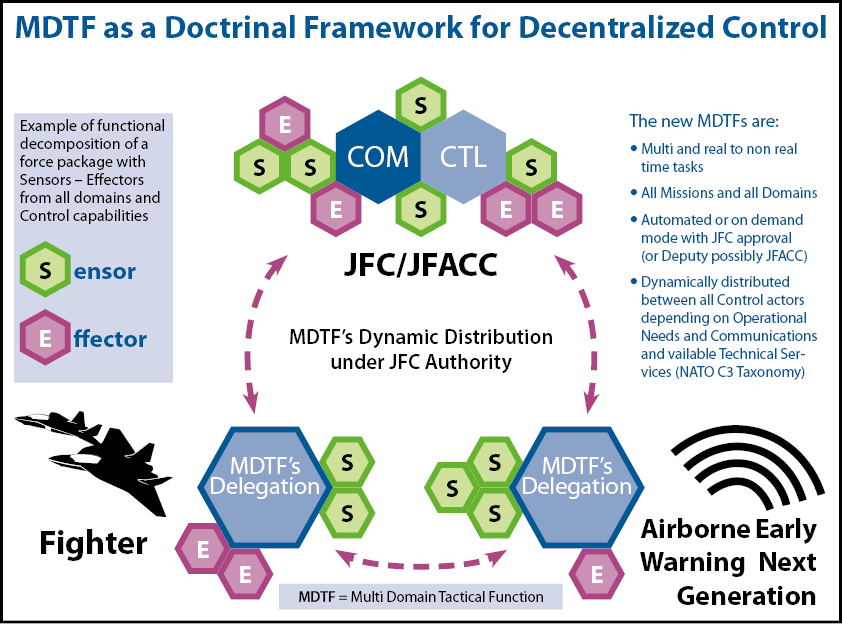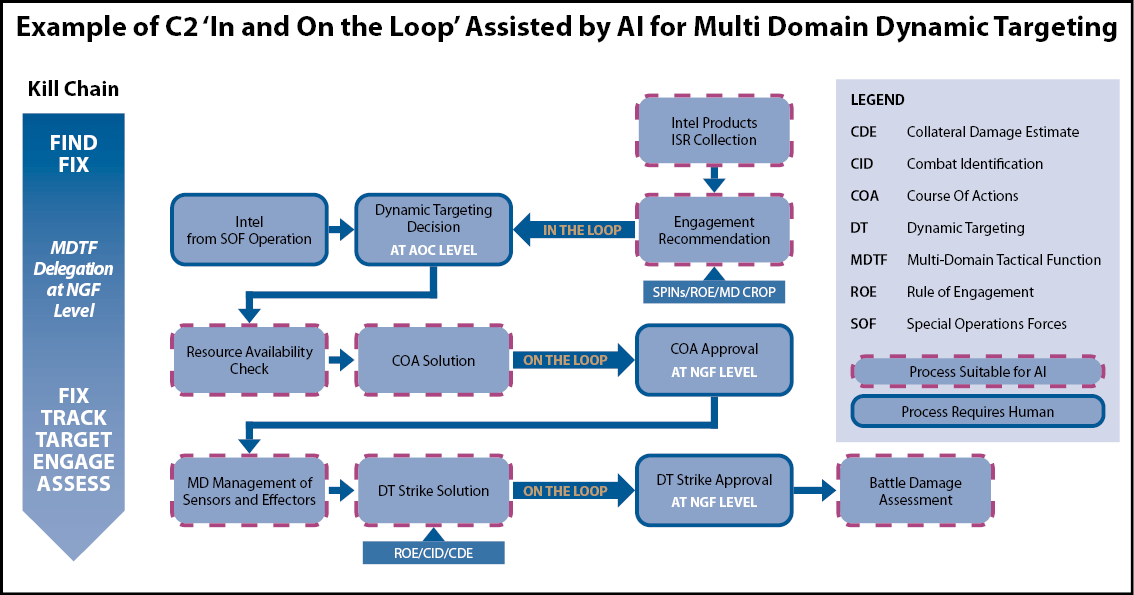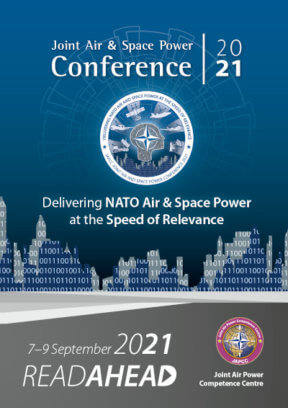Introduction
In light of today’s uncertainties, there is a shared realization that NATO’s Air supremacy which has underpinned military operations since the 1980s is no longer a given. The playing field is being levelled due to an increasing number of peer and near-peer threats from resurging and emerging potential opponents. This is accompanied by a continued presence of asymmetrical conventional threats from rogue or failing states, or terrorist organizations. When facing such threats, two main trends can be observed. The proliferation of military capabilities, due to lower technological entry barriers, is leading to more denied environments, and spreading conflicts are overstretching NATO Air Forces.
Such challenges require a paradigm shift. Relying on the sole procurement of ever-increasing sophisticated fighter aircraft will only further r educe their numbers and availability. A more favoured approach is to speed up the information flow, between manned and unmanned platforms in varying sophistication, by linking fused sensor data to the most appropriate Command and Control (C2) authority. Providing the right information in the right place at the right time will improve decision making in terms of speed and quality along the C2 cycles from the Air Component Command (ACC) to the tactical edge. Distributed decision-making is key to NATO doctrine. Contrary to past C2 approaches, the novelty lies in enriched data approaches where software, Artificial Intelligence (AI), a utomation, and satellite communication will bypass human limitations. As stated by General Terrence J. O’Shaughnessy, USAF (ret.), ‘machine- enabled insights … can identify anomalous events, anticipate what will happen next, and generate options with associated repercussions and risks.’1 This goes beyond implementing new cutting-edge technologies. Harnessing their full potential will require a doctrinal transformation, whilst ensuring adequate and meaningful human control.2 This ‘technological, doctrinal and ethical triptych‘ lies at the heart of any future combat Air system.
Adjusting to New Threats and Resulting Constraints
The increased likelihood of simultaneously facing peer or near-peer and asymmetrical opponents is imposing greater time constraints on NATO Air Forces. New threats are becoming increasingly agile and difficult to discriminate from their environment. This results in a decreasing amount of time available to execute a kill chain. Dealing with these threats in largescale operations requires the parallel execution of many missions, as well as the simultaneous processing of huge amounts of data.
Furthermore, NATO Air Forces are also operating in more complex environments, as the need to avoid collateral damage and fratricide casualties remains the same. This is the prerequisite to keeping public support. Maintaining a certain level of ‘cleanliness’ in military operations requires an increasingly complex legal framework often difficult to translate into realistic and efficient operational guidance. The aim is not only to win the war but also the peace which follows. Hence, the scope of operations needs to be increasingly comprehensive, by considering all possible direct and collateral consequences of kinetic effects in terms of physical and psychological impacts. In such complex environments, complying with the ethical framework requires human involvement to ensure moral responsibility when manned and unmanned systems operate together.
Increasing Decisional Agility with Meaningful Human Control
This new environment, with its increasingly time-constrained and complex decision-making, calls for a strong adaptation of today’s C2 model. The aim is twofold: regaining decision-making agility in terms of responsiveness and quality, as well as understanding and redefining the place of humans with regards to new information technologies. C2 is a process of implementing several decision loops in service of a strategy. It is now almost exclusively provided at command centres level such as Joint Force Air Component (JFAC) and Combined Air Operations Centre (CAOC) in a centralized mode, except for battle management which can be delegated to AWACS-like platforms.
Further accelerating the decision-making necessitates both the introduction of greater subsidiarity in the decision-making chain in a decentralized mode, and the provision of adequate decision support to the authority vested with C2 responsibility. To meet this dual challenge, this paper advocates that Battle Management, extended to multi-domains, should be conducted at all levels and when necessary down to the fighter aircraft. Distributed C2 in the cockpit will be enabled through the use of software and AI to assist pilots’ decision-making by accessing and sorting through massive data, via satellite communications. Such C2 distribution to the tactical edge fulfils the need for greater responsiveness and control resilience. Deciding to do so depends on criteria linked to mission sensi tivity3 and situational awareness.4 This need for control subsidiarity in large and contested environments implies a repositioning of humans in the decision-making loop, which can be examined through the conceptual notion of the Observe, Orient, Decide, Act (OODA) loop.
Currently, any C2 authority, benefiting from information management and synthesis tools or even the first bricks of AI applications, remains fully in charge of options development, solution choice, and execution. Such a semi-autonomous mode is called ‘Human in the Loop (HITL)’.
Cockpits being complex high tempo environments, a fighter crew member, vested with control authority, will need solutions developed by AI under his or her supervision. The crew member will retain the prerogative to select another solution or refuse a specific sequence (veto). Such a supervised autonomous mode is named ‘Human on the Loop (HOTL)‘. The authors see this last mode as the basis for C2 subsidiarity at the fighter level, as it is the best fit to compensate for human weaknesses and machine limitations during the decision-making process. In most cases, a combination of ‘In and On the Loop’ modes will allow for a speedier C2 process.
The existence of the ‘Human out of the Loop (HOOTL)’ mode in which an AI develops and executes solutions without human intervention should also be noted. While this mode may appear at first inappropriate in terms of controlling an operation where human ethical and legal judgment is deemed crucial, there are extremely high tempo situations (e.g., anti- missile defence or very high-intensity engagement) where humans are no longer able to apply sound judgment. Only a rule-based AI application would be able to exercise time-limited task control. A prerequisite being that this application follows vetted design and testing protocols through a normative process, including a massive recourse to simulation to ensure appropriate ethical and legal adherence. This last mode should remain exceptional but possible in view of an ‘exceptional but defined situation’. This normative process to ensure the trust and reliability of AI is obviously also required for ‘In and On the Loop’ modes. This robust adaptation of the C2 model on the principle of distributed multi-domain control with new AI-assisted ‘On the Loop’ authorities at the tactical edge constitutes the condition for successful agile decision-making when facing increasingly contested environments.
Requiring a Technological and Doctrinal Revolution
This new paradigm shift is made possible by the advent of large bandwidths, big data, and AI allowing varying degrees of autonomy. It will require an in-depth review of techniques, tactics, and procedures to assume control responsibilities. To illustrate this, one must focus on two areas of innovation: the Multi-Domain Combat Cloud (MDCC) and doctrine at the tactical level.
Firstly, there is currently an Information Technology and Communications structure in development capable of managing massive flows of information from the five domains (Land, Air, Sea, Cyberspace, and Space) and supporting decision-making in terms of control for collaborative multidomain combat. The framework for this structure is the ‘service oriented’ C3 NATO Taxonomy. The objective is to emerge from a patchwork of stovepiped systems at work within different communities and which hinder the integration of military effects. An MDCC, based on this ‘service oriented’ approach, will be capable to support the C2 process.
The result is the provision of shared services between all C2 players, feeding applications embedded in various systems (Air Command and Control System, Alliance Future Surveillance and Control, or fighter aircraft) and enabling dynamic d istribution of control. These applications will cater for the operational needs and offer warfare software suites and/or AI-based solutions with varying degrees of autonomy. As previously explained at the fighter aircraft level, these applications mainly fall under a ‘HOTL’ mode with an AI providing battle management options in compliance with the rules of engagement (legal framework), and with the possibility of human vetoing to ensure the meeting of ethical requirements. In this process, the concepts of AI confidence and its traceability5 will be crucial and will require specific C2 authority training during simulation sessions to be properly mastered. Likewise, if the use of AI-based on automated systems and pre-established rules seems acceptable for C2, real-time employment of machine and deep learning AI-based on autonomous systems is probably not desirable due to unpredictable proposed solutions potentially at odds with human ethics. However, usage could be possible after AI validation through the previously mentioned normative process. It is still too early to set precisely the limits and types of AI in the field of C2. The very sensitivity of this decision-making process, which ultimately comes under the responsibility of humans, calls for a cautious approach even though in any military campaign, the notion of human control already results from human judgment.
Secondly, one has to focus on doctrinal aspects and in particular, the possibility of multi-domain control delegation at the fighter level. To do so, the authors used as a basis the current Tactical Battle Management Functions (TBMF) within NATO. TBMFs already allow specific tasks’ delegations to the AWACS level and even down to the fighter but solely for Air defence. It appears that the very nature of these TBMFs based on situational awareness sharing, coordination of activities, concentration of efforts in several domains (Land, Air, and Sea) and a shorter decision cycle are relevant for broader C2 distribution. Consequently, in view of new threats and the need to multiply possible military options (notably the search for mass effect), the authors’ work has resulted in a formalized extension of these TBMFs to all Air operations around the principle of ‘multi-domain collaborative combat’. These new TBMFs have been designated as MDTFs (MultiDomain Tactical Functions) and outline a possible doctrinal framework for the 2040 horizon (as shown in Figure 1).

Above all, MDTFs provide the doctrinal framework for C2 distribution through the MDCC at the most appropriate level and in real-time, depending on the operational needs, the available platforms, the state of communications, as well as the workload transfer needs between the various C2 players. To summarize, these MDTFs make it possible to carry out a permanent redistribution of the OODA loops and to reconstruct the design of force packages according to the operational constraints.

Figure 2 shows a notable acceleration of the decision-making process through C2 delegation and a functional decomposition of force packages no longer based on functions aggregated on a single platform but on the combination of functions from all available platforms. This new approach will pave the way for highly tailored and faster multi domain kill chains.
Conclusions
A strong link exists between the amount of information to be processed, the tempo and the position of humans in the decision process. The faster it goes, the more humans will be ‘On the Loop’. Hence, any decision regarding Battle Management, taken in a fighter aircraft, should mostly be ‘On the Loop’. Nevertheless, ‘In the Loop’ has its virtues in well-staffed environments where the temporal pressure is lower and the C2 authority is more familiar with the potential options to be decided. Hence, C2 will require mostly a combination of ‘In and On the Loop’ modes.
As there are no evident ethical issues with the ‘On the Loop’ mode when supported by trusted and reliable AI, significant C2 delegations can be given to properly-equipped new generation fighter aircraft to speed-up the decision process where there is a specific need for reactivity and resilience. These delegations will be allowed through the MDTFs supported by the MDCC. Efficiency and adherence to ethical standards can both be achieved.











